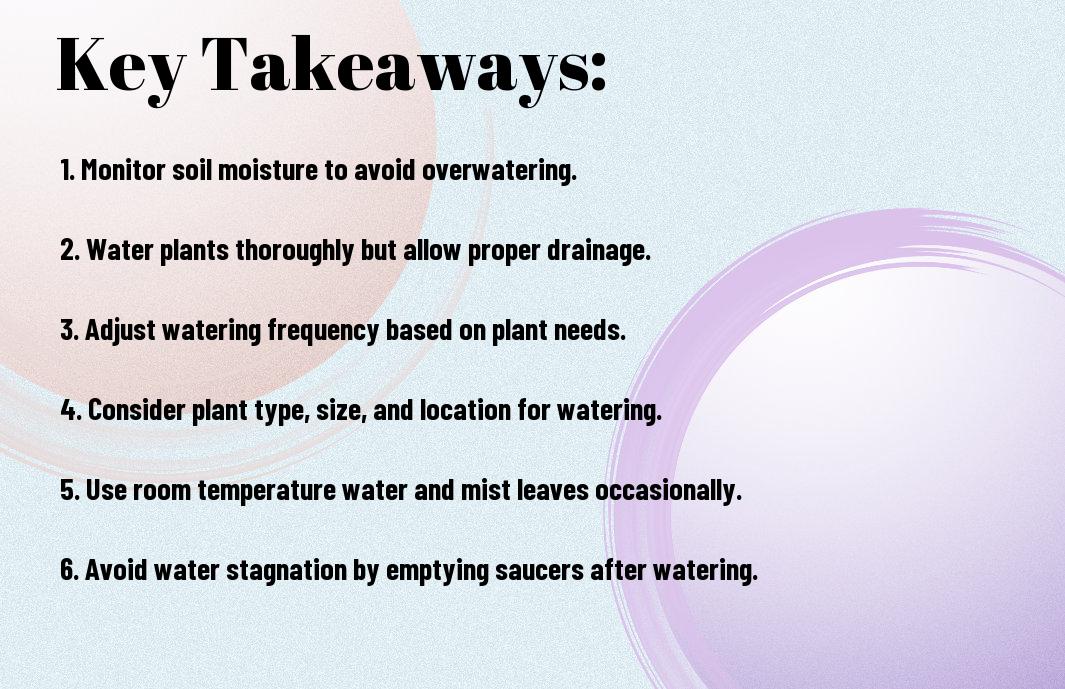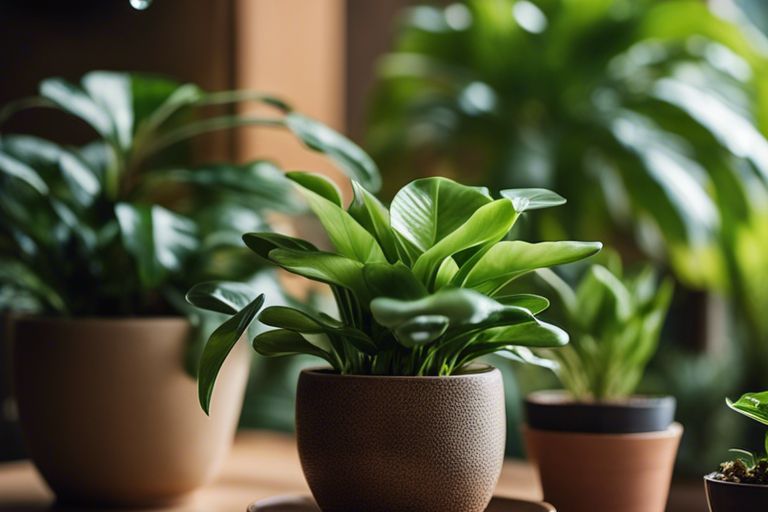Most houseplant owners struggle with the common question: how often should I water my house plants? The key to keeping your indoor plants healthy and thriving lies in understanding their individual needs. Overwatering can lead to root rot and underwatering can cause stress and wilting. Factors such as plant type, soil type, pot size, and environmental conditions all play a role in determining the watering frequency. In this blog post, we will discuss the general guidelines for watering various types of houseplants and provide tips on how to create the perfect watering schedule for your indoor garden.
Key Takeaways:
- Adjust watering frequency based on plant needs: Different plants have different watering requirements, so it’s important to understand the specific needs of each plant you have.
- Consider factors like soil, light, and humidity: Pay attention to the type of soil your plants are in, the amount of light they receive, and the humidity levels in your home, as these factors can affect how often you should water them.
- Check plants regularly: Monitor your plants regularly for signs of overwatering or underwatering, such as yellowing leaves, wilting, or moldy soil. Adjust your watering schedule as needed based on these visual cues.

Understanding Your Plants’ Needs
While caring for your house plants, it is crucial to understand their individual needs. Different plants have different requirements when it comes to watering, light exposure, and soil conditions. By familiarizing yourself with the specific needs of each plant, you can ensure they thrive in your home environment.
Types of House Plants and Their Water Requirements
To properly care for your house plants, it is necessary to know the specific water requirements of each type. Some plants, such as cacti and succulents, prefer infrequent watering, while others like ferns and peace lilies thrive in consistently moist soil. Any deviation from these requirements can lead to issues like root rot or dehydration.
| Plant Type | Watering Frequency |
|---|---|
| Cacti | Every 2-3 weeks |
| Ferns | Weekly |
| Succulents | Every 3-4 weeks |
| Peace Lilies | Bi-weekly |
| Spider Plants | Weekly |
Signs of Overwatering and Underwatering
Your plants will communicate their watering needs through visible signs. Overwatering can lead to root rot, yellowing leaves, and mold growth, while underwatering may cause wilting, browning of leaf edges, and stunted growth. Any delay in addressing these signs can result in irreversible damage to your plant’s health.
A key point to remember is that the majority of house plants are more tolerant of being underwatered than overwatered. This is because overwatering can quickly lead to root rot, which is a severe condition that is often challenging to reverse. Regularly inspecting your plants for signs of both over and underwatering is crucial to maintaining their overall health.
Watering Techniques and Best Practices
Once again, proper watering is crucial for the health and vitality of your house plants. Understanding the right watering techniques and best practices can make a significant difference in the well-being of your indoor greenery.
Methods of Watering House Plants
On top of the list is the bottom-up watering method, where you place your plant in a saucer filled with water and allow it to soak up moisture through the drainage holes in the pot. Alternatively, you can use a watering can with a narrow spout to water directly at the base of the plant, avoiding wetting the foliage which can lead to diseases.
Timing and Frequency for Optimal Plant Health
Methods optimal for watering house plants vary based on the type of plant, its size, environment, and season. It is generally recommended to water plants when the top inch of the soil feels dry to the touch. Overwatering can lead to root rot, while underwatering can cause plants to wilt and suffer. Consider factors such as humidity levels and light conditions to adjust your watering schedule accordingly.
Another crucial aspect to consider is the frequency of watering. Plants in fast-draining pots may require more frequent watering than those in ceramic pots. Develop a consistent watering routine to help your plants thrive and prevent issues related to inconsistent moisture levels.
Seasonal Considerations
Adjusting Watering Schedules in Different Seasons
Your house plants’ watering needs can vary greatly depending on the season. During the summer months, plants tend to require more frequent watering due to the higher temperatures and increased sunlight. In contrast, during the winter, when plants are dormant and there is less light, they typically need less water. It’s necessary to pay attention to your plants’ individual needs and adjust your watering schedule accordingly.
Special Care During Extreme Weather Conditions
During extreme weather conditions such as heatwaves or cold snaps, your house plants may need special care to ensure their survival. High temperatures can cause soil to dry out quickly, leading to dehydration in plants. On the other hand, freezing temperatures can damage roots and leaves. It’s crucial to monitor your plants closely during these conditions and provide extra water or insulation as needed.
For instance, during a heatwave, you can place your plants in a cooler area away from direct sunlight and mist their leaves to increase humidity. Alternatively, during a cold snap, you can cover your plants with a blanket or move them indoors to protect them from the frost.
Tools and Resources
Utilizing Moisture Meters and Other Gadgets
Unlike guesswork, technology can offer a precise solution to monitor the moisture levels in your plant’s soil. With moisture meters, you can accurately determine when your houseplants need watering. These handy gadgets come in various types, from simple probe meters to more advanced digital tools that provide detailed readings.
Creating a Watering Calendar or Reminder System
Creating a watering schedule or using a reminder system can help you stay on top of your plant care routine. By setting up a regular watering calendar or utilizing apps with watering reminders, you can ensure that your plants receive the right amount of water at the right time. This systematic approach can prevent overwatering or underwatering, which are common causes of plant problems.
Reminder systems can be especially useful for individuals with busy schedules or those who tend to forget about plant care tasks. By incorporating technology or physical calendars into your routine, you can improve the health and longevity of your indoor plants.
Final Words
Considering all points, the frequency of watering your house plants ultimately depends on various factors such as the type of plant, its size, the potting mix, and the environment it is placed in. It is important to regularly check the moisture levels of the soil and adjust your watering schedule accordingly. Overwatering is just as harmful as underwatering, so finding the right balance is key to keeping your plants healthy. Keep in mind, it is better to underwater than overwater, as most plants can recover from a lack of water, but not from root rot caused by excess water. By closely monitoring your plants and understanding their specific needs, you can ensure they thrive and bring life to your living spaces.
FAQ
Q: How often should I water my house plants?
A: The frequency of watering your houseplants depends on various factors such as the type of plant, size of the pot, temperature, humidity, and season. As a general rule of thumb, most indoor plants prefer to dry out slightly between waterings. You can check the moisture level by sticking your finger into the soil; if it feels dry about an inch down, it’s time to water. Overwatering is a common mistake, so it’s better to underwater than overwater. Always adjust your watering schedule based on the specific needs of each plant.
Q: What are some signs that indicate my houseplants need water?
A: There are several visual cues that your houseplants may display when they need water. Some common signs include wilting or drooping leaves, yellowing or browning of leaves, dry and crispy leaf edges, and a general lack of vitality. However, it’s important to remember that these symptoms can also be caused by other factors such as overwatering, inadequate light, or pests. Therefore, it’s crucial to assess the overall health of the plant and consider all possible causes before adjusting your watering routine.
Q: Are there any specific watering tips for different types of houseplants?
A: Yes, different houseplants have varying water requirements based on their species and environmental preferences. For example, tropical plants like ferns and peace lilies prefer consistently moist soil, while succulents and cacti thrive in well-draining soil and require less frequent watering. It’s important to research the specific needs of each plant you have and tailor your watering schedule accordingly. Additionally, factors such as the season, temperature, and humidity levels in your home can also influence how often you should water your houseplants.
